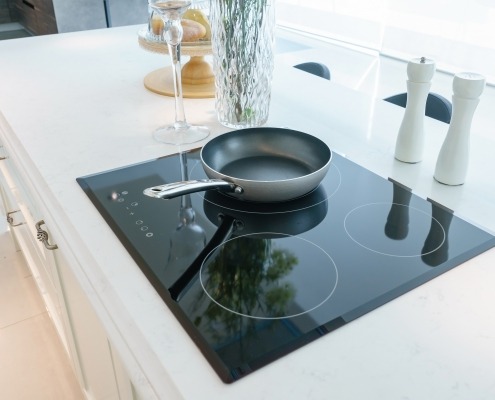How to test a GE range element switch that is not heating
Steven E / Monday April 14, 2025
Is your GE electric range leaving you in the cold with surface elements that refuse to heat up? Don’t worry—before you dial a repair technician, learn how to identify and fix the issue yourself with our easy-to-follow guide. Check out the video below to discover how you can quickly troubleshoot and get back to cooking in no time!
Looking for the right part? Enter your appliance model number below to find the exact match and get your appliance running like new again!
If your GE electric range surface elements aren’t heating, the problem may be with the surface element switches. These parts are responsible for controlling the flow of electricity to the surface element. Before you call for a repair technician, you can quickly test the part yourself to determine if it’s the source of the issue. By following the steps outlined in this guide, you’ll have the knowledge to troubleshoot the problem and get your range back up and running.
If you find out that you need any replacement parts for your appliance, you can enter your model number at AppliancePartsPros.com to order them. Most orders arrive in just two business days, and we have thousands of free guides to show you how to install your new parts.
The troubleshooting information provided in this article is based on model number 911.9342191 and may not apply to your specific appliance model. We recommend consulting your manufacturer’s documentation or contact us with any questions.
Watch here: How To Test A GE Electric Range Surface Element Switch WB23M24
Tools and materials
- Phillips head screwdriver
- Multimeter
The specific tools required may vary depending on the model of your appliance and the type of fasteners used on it.
Read more: Electric Range Element Won’t Heat: Top 7 Reasons & Fixes
Safety precautions
When working on any appliance, remember to keep safety first. Here are some tips to keep in mind:
- Always power off and unplug your appliance or switch off the circuit breaker before attempting any maintenance or replacement work. This keeps you safe by preventing any risk of injury from electric shock.
- Always power off and unplug your appliance or switch off the circuit breaker before attempting any maintenance or replacement work. This keeps you safe by preventing any risk of injury from electric shock.
- Wear insulated work gloves to protect your hands from sharp metal parts, pinching hazards and debris.
- Take your time and don’t rush while working to prevent accidents and personal injuries.
- Work in a well-lit area so you can clearly see and access the interior parts.
- Check your user manual to see if there are specific installation or safety instructions for your part or appliance.
- Be gentle when handling or removing parts. Excessive force might damage the appliance or cause injury.
- Wear safety glasses when working with chemicals, dust or cleaning large debris to prevent injury.
- If the appliance has recently been used, give it plenty of time for any heating parts to cool down before working on it.
- Take pictures or make a note of wiring terminals or other connections before disconnecting to prevent any problems with reassembly.
- When working with wires, avoid touching any exposed wires or terminals. If you need to touch a wire, use a non-conductive tool or wear insulating gloves to prevent electrical shock.
Read more: How to replace a terminal block on an electric range
Element switch testing
LIVE VOLTAGE WARNING: For this test, the appliance needs to be plugged in and powered on. Please be very careful to protect yourself from electric shock, which has the potential to cause serious injuries. Don’t ever test live voltage if you’re uncomfortable using a multimeter.
Option 1: Pull the element out
- Ensure the range is plugged in and powered on.
- Set a multimeter to AC voltage.
- Pull the element out of the range.
- Put one multimeter probe in one slot of the terminal block and the other probe in the other slot.
- Turn the switch on.
- If the multimeter reads 240 VAC, then the switch is sending the correct voltage to the element.
Option 2: Checking the wiring
- Ensure the range is plugged in and powered on.
- Set a multimeter to AC voltage.
- Locate the two wires running from the receptacle to the switch.
- Follow those two wires back to the switch terminals.
- Turn the switch on.
- Check the voltage at the two terminals where the wires from the receptacle are connected.
- If you see a reading of 240 VAC, then the switch is providing the correct voltage.
Troubleshooting
- If the voltage is not correct, there may be an issue with the voltage going to the switch or the switch itself may be defective.
- If the other elements are working, the problem is likely with the switch.
- Check the wiring diagram for your model to verify the incoming voltage to the switch.
- If the switch is good, then something else may be preventing the surface element from heating properly.
Read more: 6 safety tips for using an electric range
Additional information
Thank you for reading! We hope this guide helped you get your GE range working again.
If you have any other appliance repair needs or projects, don’t hesitate to explore our other troubleshooting guides and videos.
If you need replacement parts or some extra help with ordering them, grab your model number and head over to AppliancePartsPros.com, where you can chat with a pro, read our DIY blog and more.
Don’t forget to subscribe to us on YouTube and follow us on Facebook, Twitter and Instagram!
With nearly a decade of experience in providing top-notch customer service regarding appliance parts and repair, Steven enjoys sharing practical advice, troubleshooting tips, and interesting information to help readers stay informed.





